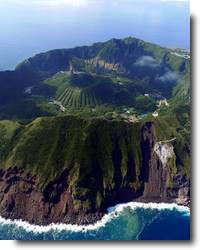こ れ は 何? - What is this?
Did you know…
... Regalia of the Emperors of Japan consists of three objects: a sword, a jewel and a mirror?
The so-called Three Sacred Treasures are: a sword (Kusanagi) representing the value; a mirror (Yata no Kagami) which represents wisdom and is supposed to come from the Amaterasu herself, who left his cave to see his reflection in it; and a jewel or necklace (not magatama Yasakani) representing benevolence.
Unlike royalties from other monarchies in the world, these objects are only used in the coronation of a new emperor, which is not a public ceremony, so few people have managed to actually see them, and there are no photographs or drawings the same.
... Japanese territory consists of a total of 3700 islands?
This amount depends on the source consulted (Wikipedia the islands rise up to 6852), but much depends on the "definition" of island is made. Wikipedia count up the rocks that are larger than the diameter 10m diameter. The data of the 3700 islands comes from the website of a Japanese government department.
... The Japanese constitution drafted a group of officials from the US Army in less than 15 days?
After the occupation of Japan by the American forces, General MacArthur as commander of the occupation forces, ordered a group of army officers very quickly to draft a constitution that laid the foundations that traces the Japanese country towards a regime political akin to the US and not to return to never represent the threat had assumed during World War II.
This constitution was based on the constitutions of the most advanced countries of the world, regardless of political demands as keeping the emperor, but as a civil figure, and the prohibition of having an army, many consider this constitution it was the most advanced of the time. Personally I think if it was really that certainly was because politicians did not have any say in it, and therefore not had to reach agreements "halftone" to please each other.
... Under Article 9 of its constitution, Japan has renounced war and have armed forces?
This controversial Japanese constitution says:
"Aspiring sincerely to an international peace based on justice and order, the Japanese people forever renounce war as a sovereign right of the nation and the threat or use of force as means of settling international disputes.
In order to carry out the wishes expressed in the preceding paragraph, shall not be maintained hereinafter forces on land, sea or air as well as other war potential. The right of belligerency of the state will not be recognized. "
... Although as indicated in Article 9 of its constitution, Japan has one of the strongest armies in the world, especially its navy?
With the outbreak of the Korean War, American troops occupation of Japan were redeployed on the Korean peninsula, and were presented with a problem with security of Japan to the communist threat.That's why "were removed from the manga" what would denominating "Japanese Self-Defense Forces."This alleged police force ended up being de facto created an army to defend the country from a possible spread of communism and powerful enough to move US troops force the Korean front.
As the constitution that had been imposed on the Japanese prevented them from creating an army, they gave civilian to military artifacts names.
... Many Japanese refer to foreigners as "nekojita" (猫 舌) (lit. cat's tongue) because they say we are incapable of hot foods or drinks?
The expression is not exclusive reference to foreigners, but wholly generic to indicate the inability to take food as hot as they usually do, but if you generally consider that foreigners have this disability.
... In Japan drive on the left since time immemorial to avoid crashing swords?
Although it can be assumed that the Anglo-Saxon influence is causing in Japan is driving on the left, nothing is further from the truth. Japan already traveling on the left long before they even knew they existed Europe.
The reason we search samurai swords, which they considered as an indivisible part of themselves. For any samurai was an outrage that someone touch their swords. Thus, if two samurai crossed a road, going-is to the left, in vetch to the right as is more common in the West, it is prevented accidentally swords brushed, and so unnecessary duels were avoided.
... The longest time in an Olympic marathon is 54 years, 8 months, 6 days, 8 hours, 32 minutes and 20 seconds?
This mark is the Japanese marathon athlete at the Olympics in Stockholm, because of the heat that could not finish the marathon. Years later, thanks to a Swedish newspaper, managed to finish the race.+ Info on the website of the Eikyo Magazine .
... To date Japan has achieved 397 olympic medals?
Altogether it has achieved 131 gold medals, 126 silver medals and 140 bronze medals, with his best performance to London 2012 the Athens 2004 with 37 medals, including 16 gold. In its Olympic Games in Tokyo 1964, also he won 16 gold medals, but in total only got 29 medals. London 2012 have achieved 38 medals: 7 gold, 14 silver and 17 bronze.
... The original name is Gojira Godzilla (ご じ ら)?
The most famous of Japanese screens monster, known in the West as Godzilla, actually called Gojira in its original version. In fact, in the American production (on which I will not review) of this monster, when they are talking to a Japanese fisherman survived a monster attack, the calls by name in the original version.
... Godzilla (ご じ ら) developed their own sign language?
Unlike the films of major American monsters, they used the technique of "stop motion" to give life to his monsters, most scenes were filmed Godzilla on scale models, with a deep person in a latex suit monster.
This person, who was the same since the creation of the monster until the retirement of the "actor" (?), Was developing a sign language interpreted the monster when he was happy or when angry, even to the extent of having a kind of "dance" to the greatest celebrations.
And we say that it was to get to the end, because the latex suit was considerably thicker and heavier, and had to be extremely difficult to make any moderately complicated with it on the move. In fact, you could not get in and out of it without help.
... In the history of the Oscars, four Japanese films have won the award for Best Foreign Language Film?
The four winning films of this Oscar have been Rashomon Akira Kurosawa in 1951, The Gates of Hell (Jigokumon) of Teinosuke Kinugasa in 1954, Samurai (Miyamoto Musashi) Hiroshi Inagaki in 1955 and Bachelor (Okuribito) Yojiro Takita in 2008 .
As a curiosity that wanted to nominate search the movie "Letters from Iwo Jima," Clint Eastwood, as it was filmed in Japanese, but could not be because an additional condition of this award is that movies can not be North American production.
... Godzilla (ご じ ら), the monster created by radioactivity destroyer went from Tokyo to Japan's savior?
Although the first film, Godzilla (ご じ ら) saga destroyed the city of Tokyo as the series progressed the terrible monster was softening, making it suitable for young audiences, and eventually became the savior of Japan to the various monsters that threaten the country. That if, often causing destruction "helping" was comparable to that of "bad monster", but he did it with good intentions.
... In Japan there was a republic?
Albeit very briefly, in the north of Japan, which is the current Hokkaido (Ezo was called then), between 1868 and 1869 the Republic of Ezo was proclaimed.
After the fall of the Tokugawa Bakufu and Meiji Restoration, many supporters of the last shogun warriors did not accept his resignation and continued to fight against the imperial forces. They were reorganized in Hokkaido, where the December 25, 1868 established the Republic of Ezo. His first and only president was Takeaki Enomoto, a former admiral of the Tokugawa fleet, and the capital of the Republic stood at Hakodate.
After the victory of the imperial troops invaded the island, the Republic of Ezo was officially to exist on June 27, 1869. On August 15 of that year the island was renamed Hokkaido (District of the North Sea).
... The atomic bomb dropped on Hiroshima was called "Little Boy"?
The atomic bombing of Hiroshima, the second of three that were made as a result of the Manhattan Project (the first was launched as a test in the desert of Alamogordo, Arizona, USA), was a uranium bomb that was dropped by the bomber model B29 Enola Gay at 08:15 h (local time).
It is estimated that direct killed by the explosion and died later from the effects of radiation, at the end of 1945 140,000 people died in Hiroshima.
... The atomic bomb dropped on Nagasaki had the name of "Fat Man"?
The atomic bombing of Nagasaki, the third of the three that were made as a result of the Manhattan Project (the first was launched as a test in the desert of Alamogordo, Arizona, USA; and the second was released three days before Hiroshima) it was a plutonium bomb that was launched by the model B29 bomber Bockscar at 11:01 h (local time).
It is estimated that direct killed by the explosion and died later from the effects of radiation, in late 1945, 80,000 people died in Nagasaki.
... The failure to Kyoto during WWII bomb was due to a honeymoon?
During WWII, he was the expert Edwin O.Reischauer Corps American military intelligence, so he attributed the decision to respect shelling the ancient Japanese capital. However, in an autobiography, Reischauer himself said that the real architect of this decision was the Secretary of War, Henry L.Stimson, who admired this city that had happened in her honeymoon, decades earlier



Comentários